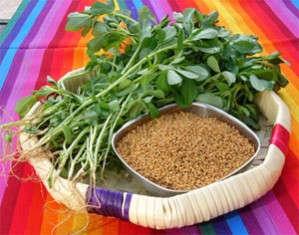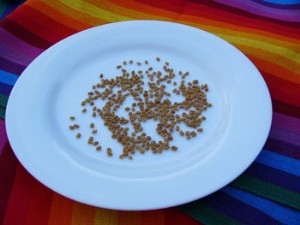Special Feature: Products Sally Recommends
Fenugreek
 Fenugreek, one of the earliest spices known to man belongs to the bean family trigonella foenumgracum. It blooms white flowers in the summer and has very aromatic seeds. Small and oblong shaped yellowish brown seeds of the fenugreek plant have a warm and slightly bitter taste. It is rich in vitamins and minerals and is high in protein.
Fenugreek, one of the earliest spices known to man belongs to the bean family trigonella foenumgracum. It blooms white flowers in the summer and has very aromatic seeds. Small and oblong shaped yellowish brown seeds of the fenugreek plant have a warm and slightly bitter taste. It is rich in vitamins and minerals and is high in protein.
Fenugreek is indigenous to western Asia and southeastern Europe. Now it is grown in India, Morocco, Egypt and England. The herb can grow to be about two feet tall. It blooms white flowers in the summer and has very aromatic seeds. Iran has a very rich tradition in cooking with fenugreek leaves. Ethiopian spice mixture berebere contains small amounts of fenugreek. It was introduced in India by Arab traders.
It has a long history as both a culinary and medicinal herb in the ancient world. The Egyptians, Greeks and Romans used fenugreek for medicinal and culinary purposes. In ancient Egypt fenugreek was used for the mummification process. During the Middle Ages it was used as a medicinal plant in Europe. Fenugreek is also known in Northern and Eastern Africa. It is widely used in the West, Central and South Asia.

Although it is a legume, it is widely used as a spice in India and it is an integral part of many Indian spice blends. Both fresh leaves and seeds of fenugreek are used in Indian cuisine. Fenugreek leaves, which are high in iron, are used as a leaf vegetable in curries as well as Indian flat breads. Uncooked fenugreek seeds have an unpleasant, bitter taste, so the seeds are usually roasted and ground before use to mellow the bitterness. Dry roasting enhances the flavor and reduces the bitterness of fenugreek seeds. It needs close attention while toasting; it turns reddish brown and tastes very bitter when over roasted.
Green Mango Pickle
Chethumaangakari
Chethumaangakari is a simple mango pickle with a short shelf life. But it is so tasty there will be nothing left to store after a couple of days. It stays fresher for a week if refrigerated. If you like your food spicy, try it as a relish. It also pairs very well with Mexican and Southwestern dishes.
2 medium size firm green mangoes
Salt to taste
½ cup vegetable, corn, or canola oil
1 teaspoon mustard seeds
½ cup cayenne pepper powder (or less if you prefer a milder taste)
2 tablespoons of fenugreek seeds, lightly toasted and powdered
½ teaspoon asafoetida powder
A few curry leaves
Wash and cut mangoes into small thin slices. Sprinkle salt over them and keep covered as you assemble the other ingredients. In a skillet, heat the oil and add the mustard seeds. When they start spluttering, add the cayenne, fenugreek, asafoetida, and curry leaves. Reduce the heat to low, add salted mango pieces, and mix well. Remove from the stove and let the mixture cool. Store it in glass bottles in the refrigerator. It tastes best the second day, after the mango pieces have absorbed the spices. Reduce the amount of cayenne if you prefer less spicy pickle.
Makes 2 to 2 ½ cups
Variation: Tart and crunchy green granny smith apples make an excellent substitute for mangoes. Core, but do not peel 2 apples and slice them exactly like the mangoes. Sprinkle them with salt and a tablespoon of fresh lemon juice per apple, and let them rest for a few minutes while you prepare the spice mix. Follow the mango pickle recipe to finish pickling. It stays fresh in the refrigerator for a week.
![]()
A financial analyst turned freelance food writer, Ammini Ramachandran, writes about the history, culture and cuisine of her home state Kerala, India, on her web site https://www.peppertrail.com. Her recipes and articles have been featured in The Providence journal, Flavor & Fortune, www.leitesculinaria.com, and www.ThingsAsian.com. She is working on a cookbook about the vegetarian cuisine of Kerala against a backdrop of cultural and culinary history. She is a member of the International Association of Culinary Professionals and Culinary Historians of New York.
Note: This information was accurate when it was published. Please be sure to confirm all rates and details directly with the businesses in question before making your plans.



